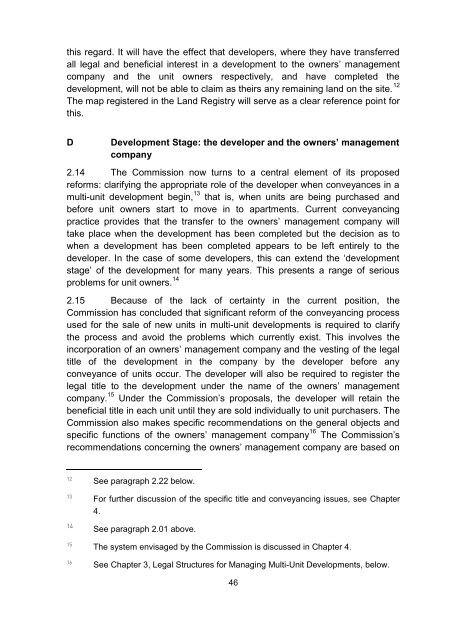Report on Multi-Unit Developments - Law Reform Commission
Report on Multi-Unit Developments - Law Reform Commission
Report on Multi-Unit Developments - Law Reform Commission
Create successful ePaper yourself
Turn your PDF publications into a flip-book with our unique Google optimized e-Paper software.
this regard. It will have the effect that developers, where they have transferred<br />
all legal and beneficial interest in a development to the owners‘ management<br />
company and the unit owners respectively, and have completed the<br />
development, will not be able to claim as theirs any remaining land <strong>on</strong> the site. 12<br />
The map registered in the Land Registry will serve as a clear reference point for<br />
this.<br />
D<br />
Development Stage: the developer and the owners’ management<br />
company<br />
2.14 The Commissi<strong>on</strong> now turns to a central element of its proposed<br />
reforms: clarifying the appropriate role of the developer when c<strong>on</strong>veyances in a<br />
multi-unit development begin, 13 that is, when units are being purchased and<br />
before unit owners start to move in to apartments. Current c<strong>on</strong>veyancing<br />
practice provides that the transfer to the owners‘ management company will<br />
take place when the development has been completed but the decisi<strong>on</strong> as to<br />
when a development has been completed appears to be left entirely to the<br />
developer. In the case of some developers, this can extend the ‗development<br />
stage‘ of the development for many years. This presents a range of serious<br />
problems for unit owners. 14<br />
2.15 Because of the lack of certainty in the current positi<strong>on</strong>, the<br />
Commissi<strong>on</strong> has c<strong>on</strong>cluded that significant reform of the c<strong>on</strong>veyancing process<br />
used for the sale of new units in multi-unit developments is required to clarify<br />
the process and avoid the problems which currently exist. This involves the<br />
incorporati<strong>on</strong> of an owners‘ management company and the vesting of the legal<br />
title of the development in the company by the developer before any<br />
c<strong>on</strong>veyance of units occur. The developer will also be required to register the<br />
legal title to the development under the name of the owners‘ management<br />
company. 15 Under the Commissi<strong>on</strong>‘s proposals, the developer will retain the<br />
beneficial title in each unit until they are sold individually to unit purchasers. The<br />
Commissi<strong>on</strong> also makes specific recommendati<strong>on</strong>s <strong>on</strong> the general objects and<br />
specific functi<strong>on</strong>s of the owners‘ management company 16 The Commissi<strong>on</strong>‘s<br />
recommendati<strong>on</strong>s c<strong>on</strong>cerning the owners‘ management company are based <strong>on</strong><br />
12<br />
See paragraph 2.22 below.<br />
13<br />
For further discussi<strong>on</strong> of the specific title and c<strong>on</strong>veyancing issues, see Chapter<br />
4.<br />
14<br />
See paragraph 2.01 above.<br />
15<br />
The system envisaged by the Commissi<strong>on</strong> is discussed in Chapter 4.<br />
16<br />
See Chapter 3, Legal Structures for Managing <strong>Multi</strong>-<strong>Unit</strong> <strong>Developments</strong>, below.<br />
46

















